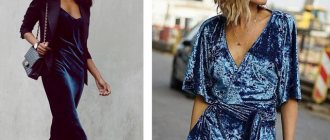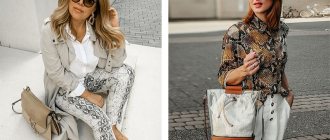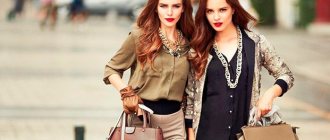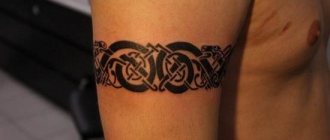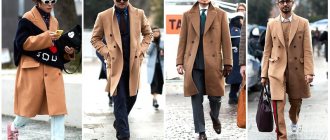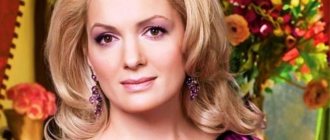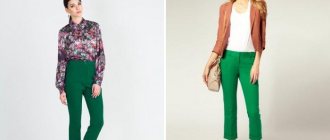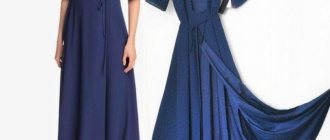In the fashion industry, the 60s of the last century became a turning point. It was at this time that the women's wardrobe became more democratic, miniskirts, loose, short A-line dresses appeared, as well as trousers and suits that came from the men's wardrobe.
The rising fashion houses of Pierre Cardin, Yves-Saint Laurent and Paco Rabanne, inspired by space themes and pop and op art trends, presented unimaginable collections filled with bright colors, new materials, textures and prints. It's no surprise that these trends are once again popular.
Graphic prints and minis
On the left is a mini from the 60s; on the right - Moschino collection 2018-2019
On the left is the Yves Saint Laurent collection, 60s; right - Louis Vuitton 2021 collection
On the left - Sophia Loren, 60s; on the right - Bershka polka dot dress spring-summer 2021
The most scandalous purchase in the 60s was the miniskirt. And today it is relevant! If you want to demonstrate your knowledge of fashion history, then choose a model with a graphic pattern - it could be a check, strip, or polka dot.
Women's dress from VISÀVIS, price: from 999 rub.
WHERE CAN I BUY?
What: women's dress Where: online clothing and lingerie store VISÀVIS Phone Website : visavis-moda.yapokupayu.ru
"Keeping up with the times"
From the second half of the 50s, fashion in the Soviet Union followed Western trends, although it did not change so quickly. Some things came from there unchanged, but some were not perceived as beautiful by Soviet fashionistas. For example, the length of skirts or dresses in the Soviet Union did not rise above the knee for a long time, although European fashionistas were already flaunting miniskirts with all their might. The fashion of Soviet citizens was calmer and more practical, meeting the demand of middle-class buyers, and not just rich people. Also, Soviet fashion designers sewed outfits that had improved functionality and were approved by medical workers.
But the main problem of the Soviet fashion world was the size grid. In all advanced countries, outfits were cut depending on height and fullness, and in the Soviet Union they adhered to the average ratio of height and girth.
That is why domestic clothes fit many times worse than the same style from the West. When buying an outfit, most immediately went to seamstresses to have it adjusted to their parameters. To solve this problem, for 8 years, the Institute of the Garment Industry in the USSR carried out mass measurements of body parameters of all ages of the population. From the data obtained, specialists were able to develop GOST standards and new series of sizes. After the introduction of these data into the production of clothing, the majority of the population of the USSR did without individual adjustment after purchasing clothing.
The quality of tailoring and variety of models have also increased significantly. The Bolshevichka clothing factory, popular in those days, which produced large volumes of women's and children's clothing, sewed outerwear for women of different body types. In just 1 year, “Bolshevichka” managed to double the number of styles, thereby providing a huge assortment of fashionable clothes for fashionistas of the Soviet era.
Immediately there was a demand for outfits made from artificial fabrics that were loved by women and men. Citizens of the USSR were in love with the practicality of nylon, vinyl and other similar materials, because they significantly reduced the time for washing, drying and ironing their clothes. Also, a significant advantage of these fabrics was that they were cheaper than the same model made from natural fabrics. The fashion for faux fur had reached such a level that even those who could afford to buy natural ones purchased fur coats from it.
Over the knee boots
Left - Brigitte Bardot, 60s; on the right - Stradivarius heeled boots, 2021
A great addition to an image with a short skirt is over the knee boots. Today, like almost 60 years ago, high boots with flat soles or low heels are relevant. Materials can also be varied: from natural suede to synthetic fabrics.
CORSOCOMO suede boots, price: from RUB 8,800. with 25% discount, order
Leather over the knee boots CORSOCOMO, price: from 5,900 rub. with 50% discount, order
Evening dress with cap sleeves
Seamless at the waistline, the bodice is loose, without a rigid shape, one-piece with sleeves. The skirt is maxi, loose. Rollout - boat. The dress is decorated with a belt.
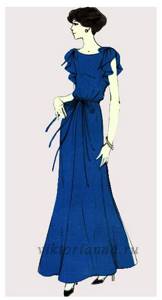
To make a dress, it is recommended to use flexible and lightweight dress fabrics in rich colors without patterns.
For a product of size 46, you need to prepare 4.5 m of material with a width of 0.96 cm.
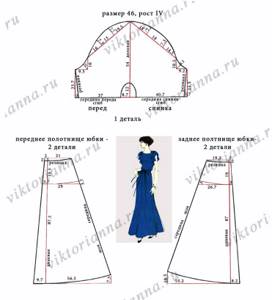
Below we offer a detailed master class on sewing a dress in the style of the 70s.
A-line dress
Left - Twiggy, 60's; on the right - Moschino collection 2018-2019
To create a more delicate look, the invention of the couturier of the 60s - the trapeze dress - is ideal. Lightweight cut, rich colors and optical graphics are an excellent option for parties or friendly gatherings.
A dress from designer Masha Goryacheva is ideal for a holiday. The model is made in black with an intricate print.
Evening dress “Jacqueline” by Masha Goryacheva, price: from 18,000 rubles.
WHERE CAN I BUY?
What: evening dress Where: designer clothing boutique MASHA GORYACHEVA Phone Website : mashagoryacheva.ru
Sleeveless mini dress
High waist dress. The armholes, roll-out line and waist are emphasized with trim made of contrasting fabric.
To sew such a model, it is best to use dress or suit fabrics, fine wool, thick silk, gabardine, crepe, jersey.
For a product of size 46, you need to collect 1.05 m of fabric with a width of 1.4 m or 2 m with a width of 0.9 m. For finishing, you need to prepare ready-made binding or contrasting fabric - 0.3 m with a width of 0.9 m.

Large accessories
On the left are fashionable frames from the 60s; on the right - Mango sunglasses, spring-summer 2021
Left - Marilyn Monroe, 60s; on the right - Bershka sunglasses, spring-summer 2021
In warm weather, sunglasses are an essential accessory to complement your minidress. Returning from the runways of the '60s are round plastic frames in a variety of bright colors, as well as the cat-eye shape that was popular at the time.
60s Fashion: Dresses
As you know, after decades, many trends return.
So the fashion of the 60s is as relevant now as it was half a century ago.
Let's talk about the most stylish styles of dresses in the early retro style.
Fashionable dresses of the 60s: features
A landmark decade in the fashion industry is the 60s of the last century. The old conservative canons were crumbling, and new ones, bolder and brighter, took their place.
It was at this time that the concept of youth trends arose, and the history of fashion was replenished with iconic names of such style icons as Catherine Deneuve, Jacqueline Kennedy, Brigitte Bardot and the unforgettable and courageous Twiggy.
The main feature that captivates dresses of the 60s is their subtle sexuality.
No flashy necklines or revealing styles, only chic and attractive elegance with a slight touch of coquetry.

Main features of 1960s fashion:
simple cut; unobtrusive finishing; lack of a large number of details.
Another recognizable feature of dresses of that time was the innovative mini length, which allowed the fair sex to demonstrate to the world the beauty and grace of women's legs.
The lack of frills, ruffles and other details that ladies of yesteryear were accustomed to was compensated for by bright prints and colors.
Bold colors, black and white patterns, contrasting tones and the now classic polka dots were still new in the 1960s and instantly became favorites of extravagant designers.
60s fashion: dress styles
Not everyone is aware that many styles that are now considered classics came to us precisely from the 60s of the last century:
Trapezoid.
A laconic and simple trapezoid is one of the symbols of that fashionable decade.
Among the details recognized were patch pockets and colored piping, which often contrasted with the main shade of the model.
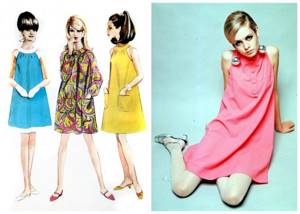
Geometric shapes also ruled the roost: square and triangular inserts of fabric of a different color created that unique highlight of the teen-style style that fashionistas of the 60s sought.
Case.
The classic fitted silhouette of a sheath dress came to us from the same times.
Simple sleeveless dresses and models with an overlaid narrow collar were especially popular.
In combination with a short length, outfits of this type look restrained, but not boring at all.
Fitted dresses with full flared skirts.
Such models were and remain relevant in all sorts of variations: with an open top, with and without sleeves, with thin and wide straps, closed and with a neckline, with a turn-down “sailor” collar and a stand-up collar...
A distinctive feature of these styles was the emphasis on the waist. It was achieved through the cut itself and large belts - both fabric ones, tied with a bow, and wide elastic belts with a large buckle.
The colors are also worthy of special attention. In the 1960s, noble colors were popular: white, blue and gray.
At the same time, one of the highlights of the decade is polka dots and bright floral prints. These trends in the fashion world are now repeated most often.
It was also in the 1960s that dresses with intricate patterns and photo reproductions began to be made.
It was a new word that, despite the passage of time, is still popular today.
Evening dresses from the 60s
The parties of those years were strikingly different from the social gatherings of the past: fiery dancing, unbridled fun and rock and roll came into fashion, which left their mark on the outfits of that time.
To make it comfortable to dance, ladies did not wear floor-length dresses - they were replaced by short skirts to or above the knee.
Their splendor allowed them to flutter and spin, and at the same time leave a lasting impression on the opposite sex.
The most popular details of ladies' evening dresses of the 60s were:
Wide belt.
A satin belt on a lace dress or vice versa looked chic.
Lush lining a la ballet tutu.
A petticoat in contrasting colors always looked very impressive.
See for yourself: white lining under a black dress or red lining peeking out from under a dark blue skirt with white polka dots.
Strapless bodice.
Emphasizes the chiseled waist and bust, and also leaves room for accessories.
In the 1960s, preference was given to bright and catchy plastic jewelry.
Modern outfits in retro style skillfully combine trends from different decades, while maintaining the main highlight - the hourglass silhouette.
The perfect complement to a 60s-style outfit is a small clutch, elegant pointed pumps and gloves.
Why are 60s style dresses so popular? First of all, these models are devoid of pretentiousness, and therefore are relevant in any decade of any century.
In addition, they perfectly emphasize the figure while hiding imperfections.
Short trapezes and sheaths look great on tall, thin girls, and fitted models with a full skirt emphasize appetizing shapes and waist.
Do you have a 1960s outfit in your wardrobe?
boats
On the left are Christian Dior pumps, 60s; in the top right photo - Stradivarius mid-heeled pumps, 2021; bottom right photo - Zara floral pumps, 2021
To complete the look, go with classic 60s shoes - pumps. Modern stylists experiment with all sorts of details and unusual colors to create an original design. Today, such shoes can be worn not only with an elegant dress, but also with ripped jeans or cropped loose-fitting trousers.
Women's shoes BRUNO PREMI in Milano Moda, price: from 6,050 rub.
WHERE CAN I BUY?
What: women's shoes Where: Milano Moda online store Phone Website : milanomoda.ru
Men's fashion
Fashionable men replaced strict Soviet trousers with pipes, bright fitted jackets with wide shoulders, shirts and ties, and cane umbrellas. And the main hairstyle became “cock”. For them, the fashionable ideal was Elvis Presley and the Beatles. But the most scarce product turned out to be... panties. The fact is that for Soviet men, the main element of underwear before was long johns, but they did not fit at all with tight trousers. Factories also produced blue half-boxes, but, firstly, they were not easy to get, and secondly, they reached almost to the knees, so they began to wear swimming trunks under pipe trousers.
Among the fabrics, corduroy and suede have become popular. Cardigans came into use, and red socks were considered the latest in men's fashion. By the way, before this there weren’t even men’s socks with any pattern or design.
The shirt had to be not only bright, but also with an apache collar, as well as slits on the sides. In addition, men wore light gray or light beige raincoats with a large collar, belt and flaps on the pockets. The main headdress was caps.

Photo: Fedotov P./TASS
In the mid-60s, white synthetic shirts gained particular love among men. Men's shoes with a narrowed toe were considered the most fashionable shoes. By the middle of the decade, the nose becomes more rounded. But it was impossible to get such shoes at a factory or store, so they were also ordered unofficially from shoemakers. Such shoes cost 20-25 rubles - this was half the minimum wage.
Many male tailors appeared in Moscow and Leningrad, the most famous among them was Alik Singer, who later emigrated to the USA. It was he who dressed the entire party elite and pop stars. Soviet citizens expected that after the “thaw” life would become even better, and real communism would come. However, Nikita Khrushchev failed to achieve visible success in the economy, so after the “thaw” an era of stagnation began.
